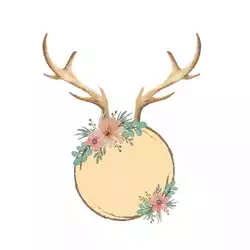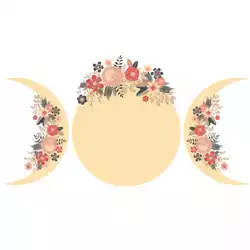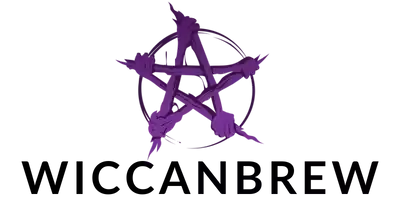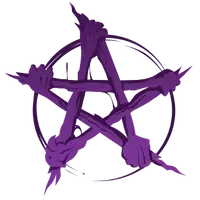Table of Contents
One of the beliefs that sets Wicca apart from other traditions and systems is its dual deity worship. Wicca looks to a Goddess and a God, and to be even more specific, The Goddess and The God or Lady and Lord. While they are not specifically named, there are always two and always one female and one male. Often, they are referred to as the Horned God and the Triple Goddess.
Introduction to the Wiccan Horned God
 The Horned God is one of the most recognized figures in Wicca, a modern pagan religion that venerates the pre-Christian gods and goddesses of Europe. The Horned God symbolizes the divine masculine principle in Wicca and is often associated with fertility, virility, and protection. He can also be seen as a protector of animals and nature.
The Horned God is one of the most recognized figures in Wicca, a modern pagan religion that venerates the pre-Christian gods and goddesses of Europe. The Horned God symbolizes the divine masculine principle in Wicca and is often associated with fertility, virility, and protection. He can also be seen as a protector of animals and nature.
The archetype of the Horned God dates back to ancient times, but his popularity has surged again in recent years due to the revival of Paganism around the world. In this article, we’ll explore the meaning of the Horned God and its importance in Wicca.
Who Is The Horned God?
The Horned God is thought to be a combination of several gods from many different cultures throughout history. Many Neopagans attribute him to Cernunnos, an ancient Celtic god who was once associated with horned beasts and fertility. Others believe he may have originated from Herne, a figure featured in British folklore and literature who wears antlers or horns on his head while riding a white horse across dark skies (sometimes referred to as “Herne’s Hunt”).
The deity has also been linked to Pan, an Arcadian god known for his music-making and rustic pastoral pursuits; Bacchus, the Roman god of wine; Osiris, an Egyptian god associated with death and resurrection; Shiva, a Hindu deity of transformation; Dionysus, the Greek god of wine; Teutates, Celtic god linked with war; Odin from Norse mythology who is often depicted wearing a horned helmet called Jackal; Enlil from Sumerian mythology who was considered lord of wind and storm clouds; Thor from Norse mythology whose weapon was called Mjollnir or Hammerhead; and Apollo (who wore horns on his chariot while traveling through Greece).
Despite all these varied origins, most Pagans today identify him as a male embodiment of Nature – the wild spaces that remain within us even while living in urban landscapes – and see him as having dominion over animals such as deer or bulls (hence why many depictions show him with horns like those found on certain animals). He’s also seen as being connected to seasonal cycles because he acts as both Lord of Death when Winter comes around but also Lord Renewal when Spring eventually returns after its icy grip has disappeared.
The Horned God and his Titles
The Horned God is the most common title/name for the God in Wicca. What you might want to remember is that while these broader titles are shared with the public, individual covens might choose to worship more specific gods, e.g., Thor, Zeus, Osiris, etc. The Horned God is often shown with large horns like a stag or goat, or ram on top of his head. Because of these horns, some might associate the Horned God with the devil, but Wicca does not include a devil (only Christianity does), so this is not the same being.
In some representations, the Horned God will have hooves and other animal characteristics in addition to being a man. This god is the one that represented the primal nature of man and his connection to the wild. He is the one who hunts, and he is the one who uses his intuition to sustain himself. He is virile and aggressive, the one who can take away life and the one who can give life through the outcomes of a hunt.
Symbology Associated With The Horned God
Since antiquity, much symbolism has been used to depict The Horned God:
- Horns represent power, strength, and protection
- Garlands indicating fertility or abundance
- A solar disk reflecting life-giving energy from our nearest star
- Antlers signify wisdom since they grow each season yet never reach their full potential until winter comes around. This is a yearly reminder that our lives evolve but is ultimately limited by time itself.
- Wild animals such as wolves or boars, since these creatures represent ferocity in battle, something The Horned God could be summoned for during times when enemies sought to destroy Pagan traditions.
- Oak trees connect him with Nature since their strong roots mean they live longer than other species while they endure whatever weathers them year after year.
Connecting With The Horned God
So how can one connect with The Horned God? One way is through a ritual, which can involve chanting invocations or offerings made at altars that might feature sacred items such as crystals, gemstones, candles, etc. If you are new to Wicca, you should do so under supervision from experienced Priests or Priestesses who lead ceremonies within covens or temples dedicated solely towards honoring this particular deity. Connecting deeply enough will allow individuals access to realms where visions await them that provide insight into aspects otherwise inaccessible through normal forms of perception. This makes it easier for people seeking advice about difficult decisions or spiritual matters moving forward into future timelines unknown but potentially illuminated by divine guidance through communing directly with this powerful figurehead within modern Paganism today.
The Triple Goddess

While not everyone agrees with the idea of a Triple Goddess, it is a common way to look at the Goddess and her many forms.
Wicca is a nature-based religion that honors the divine feminine, often referred to as “The Goddess.” Within this practice, The Goddess is believed to be made up of three aspects: Maiden, Mother, and Crone. This triad makes up what is known today as the Triple Goddess.
In her three aspects, she can be the Maiden, Mother, and Crone. These different phases of life are akin to how nature changes during the year, with the Maiden being the springtime, the mother being of birthing and mothering, and the crone being death and rebirth.
The Maiden
The Maiden represents youth and purity, and her role is primarily associated with springtime. She is a symbol of renewal, growth, and recreation. She is connected to new beginnings and potential realized. Some traditions associate her with the waxing moon, which signifies fertility and gestational power. She embodies innocence, playfulness, and creativity.
The Maiden emerges in fertility rites as the (sometimes) virginal beauty who is associated with new beginnings, new moons, and flowering.
The Mother
The Mother aspect helps us understand how opposite forces can co-exist in balance and harmony. She reminds us that there are both light and dark sides in life – joy and sorrow – but they must both be embraced if we want to evolve spiritually. Her presence is attributed to summer, providing a sense of abundance after a long period of dormancy during winter months. The Mother reigns over harvest time as abundance fuels our seasonal journey into autumn, where we prepare for a period of stillness before winter arrives.
The Mother holds more knowledge, and she protects those around her. She often gives more of herself than others might. She is focused on building a family unit and nurturing those around her.
The Crone
Lastly, The Crone marks wisdom through experience and aging gracefully. Her domain exists on the waning moon, which leads from fullness toward emptiness again — a reminder that life has cycles where endings are just beginnings in disguise for those who are paying attention. As we enter colder months at the end of fall and prepare for winter, we acknowledge our mortality through deep reflection on all that was experienced throughout the year’s cycle –from birth to death—and everything in between.
The Crone is the one who holds the wisdom of time. She is the one who is strong and practical while also being able to look at the dark side of life to see it for what it really is. She is the one who watches over transformations, including death and rebirth.
The Triple Goddess is a complete Being
Though each aspect has its own meaning, it is essential to recognize them all together as one entity because, without each other, there is no meaning or balance in their powers combined individually as one complete being—the Triple Goddess. She represents creation and destruction (which create cycles) so that their experiences contribute collectively to existence while enhancing understanding all within one cohesive sentiment:
- Everything exists because something died so something else could live.
- Changes occur in order to progress forward positively instead of remaining stagnant.
- Endings bring forth new beginnings; death brings forth rebirth
These rituals lead humanity closer towards recognition of her energy while fulfilling spiritual desires that connect us all beyond our physical limitations — an everlasting bond much like Divine Love itself!
To believers of Wicca, and other Witchcraft traditions, the Triple Goddess serves as an acknowledgment that acceptance lies within understanding how Nature intends for opposites (birth/death) to exist harmoniously together. Rather than ignoring them or fighting against them endlessly, trying not to fit into any particular structure or belief system without taking responsibility first for influencing change from within instead of seeking outside influence elsewhere. Because only then will individuals truly discover true autonomy over themselves, allowing wisdom and knowledge to come from personal self-discovery!
Wicca and deities
Not all goddesses have three aspects, and not all gods are gods of the hunt. When moving into the practice of Wicca, it can help to learn as much as you can about as many deities as you can. In doing so, you will begin to understand their unique stories and qualities while also seeing who resonates most with you. You might find you want to work with Greek deities or that you want to work with Egyptian deities. Or you might want to stick with the Lord and the Lady until you figure out what calls to your heart.
As you move through the Wheel of the Year in Wicca, think about how the cycles of the year impact the God and the Goddess. You can watch them start as being the dead and move into being ready to be reborn in the light to be a part of births and planting. Find them in the way the light moves across the land and the sky.
High Priestess Memoona is a well-known and respected spell caster and magical practitioner with more than five decades of experience. She is a master of her craft, having used her powerful abilities to bring people joy, unconditional love, and prosperity. With her unique approach to spell casting, High Priestess Memoona has helped countless individuals manifest their life dreams and achieve their goals. Her expertise and dedication to the craft have made her a highly sought-after Spell Caster, and she is proud to be able to offer her services to those who seek her aid.

